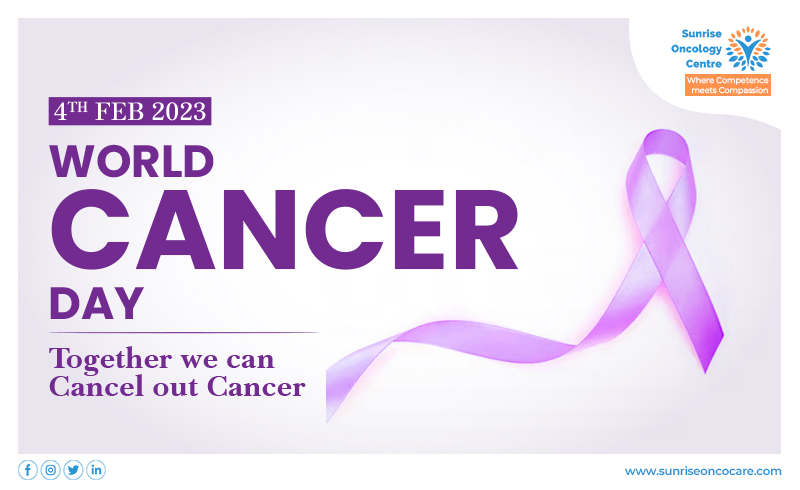Every year on February 4th, World Cancer Day is observed to raise awareness about cancer and encourage individuals and organizations worldwide to take action against the disease. Cancer is a complex and often devastating illness that affects people of all ages, genders, and nationalities.1 Despite advances in medical technology and research, cancer remains one of the leading causes of death globally, and it is estimated that the number of cancer cases will continue to rise in the coming years. Therefore, it is more important now than ever to focus on preventing, detecting, and treating cancer.
World Cancer Day is organized by the Union for International Cancer Control (UICC) and its aim is to bring together individuals, communities, and governments to work towards a common goal of reducing the impact of cancer on individuals, families, and communities. This year’s theme marks the second year of the campaign “close the care gap” which is about understanding the inequities in cancer care and taking action to make the necessary progress to address them.2
Why cancer?2
Each year, 10 million people pass away due to cancer – a higher number than the combined fatalities from HIV/AIDS, malaria, and tuberculosis.
Projections indicate that the number of cancer deaths could increase to 13 million by 2030 if no action is taken. Preventing over a third of all cancer cases is possible, and with early detection and proper treatment, another third can be cured. Adopting resource-efficient approaches for prevention, early detection, and treatment can result in saving millions of lives annually.
What is cancer?
Cancer is a condition where cells in the body grow and spread abnormally to other parts of the body. The human body is comprised of trillions of cells that usually grow and multiply to form new cells as required by the body. However, when cells become old or damaged, they die and are replaced by new cells.3
In some instances, this orderly process gets disrupted, and abnormal or damaged cells continue to grow and multiply. These cells may form tumors, which are masses of tissue that can be benign or malignant.3
Benign tumors, do not invade nearby tissues and are unlikely to grow back after removal. Although benign tumors are usually not life-threatening, some can cause serious symptoms, such as benign brain tumors.3
Malignant tumors, invade nearby tissues and can spread to distant parts of the body to form new tumors, a process called metastasis. Some cancers form solid tumors, while others, such as leukemias, are cancers of the blood and do not form solid tumors.3
Who are at risk of cancer?
Cancers have various causes, and like many other illnesses, are often the result of multiple contributing factors. It is crucial to note that some factors cannot be altered, but approximately one-third of cancer cases can be prevented by minimizing behavioral and dietary risks.2, 4
Knowing your risk factors and discussing them with your healthcare provider is important for making informed lifestyle choices that enhance your health. This information may also assist your doctor in determining if genetic testing and counseling are necessary. Some common risk factors for cancer include:2, 4
- Older age
- A personal or family history of cancer
- Using tobacco
- Obesity
- Alcohol
- Some types of viral infections, such as human papillomavirus (HPV)
- Specific chemicals
- Exposure to radiation, including ultraviolet radiation from the sun
Diagnosing cancer
A cancer diagnosis often starts with a visit to a doctor regarding unusual symptoms. The doctor will assess the person’s medical history and symptoms through a conversation, followed by conducting various tests to determine the cause of the symptoms.5
However, some people with cancer may not have any symptoms, and cancer may be detected during a medical test for another issue. Screening tests, such as colonoscopy, mammography, and Pap test, may also reveal the presence of cancer in otherwise healthy individuals. Further tests may be needed to confirm or rule out the results of the screening test.5
To make a definite diagnosis of most cancers, a biopsy is necessary. A biopsy involves removing a small amount of tissue for further examination.5
How to prevent cancer?
Prevention and early detection are crucial in reducing the impact of cancer. This can be achieved through lifestyle changes such as maintaining a healthy diet, regular exercise, avoiding tobacco and excessive alcohol consumption, and getting vaccinated against certain types of cancer. Regular check-ups and screenings can also help in the early detection and treatment of the disease.2
In conclusion, World Cancer Day is a time to reflect on the progress that has been made in the fight against cancer and to recommit to taking action to reduce its impact. Whether it’s by making lifestyle changes, advocating for better policies, supporting research, or participating in fundraising efforts, every individual has a role to play in the fight against cancer. Together, we can create a future where cancer is no longer a leading cause of death and where everyone has access to the best possible care and treatment. By taking action today, we can help ensure a brighter tomorrow.
Reference:
- World Cancer Day- “I am and I will”, https://blog.mygov.in/world-cancer-day-i-am-and-i-will/, accessed on 2nd February 2023.
- World Cancer Day: a leading international awareness day, https://www.worldcancerday.org/about-us, accessed on 2nd February 2023.
- What Is Cancer?, https://www.cancer.gov/about-cancer/understanding/what-is-cancer, accessed on 2nd February 2023.
- Understanding Cancer Risk, https://www.cancer.net/navigating-cancer-care/prevention-and-healthy-living/understanding-cancer-risk, accessed on 2nd February 2023.
- What is Cancer?https://www.cancer.net/navigating-cancer-care/cancer-basics/what-c%C3%A1ncer, accessed on 2nd February 2023.

